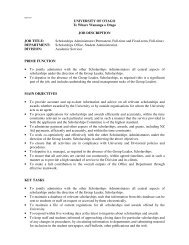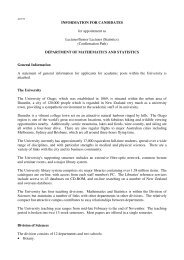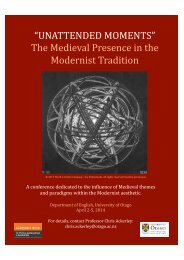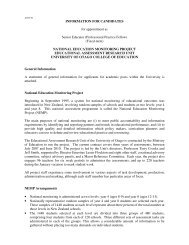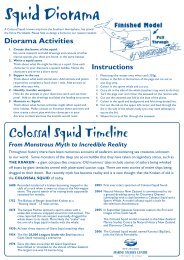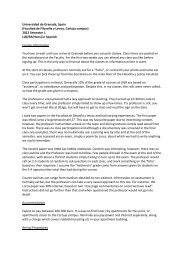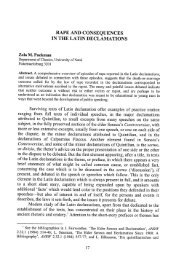scholia - University of Otago
scholia - University of Otago
scholia - University of Otago
You also want an ePaper? Increase the reach of your titles
YUMPU automatically turns print PDFs into web optimized ePapers that Google loves.
'Form and Meaning in Bacchylides' Fifth Ode', D. L. Cairns 35<br />
this poem gives the lie to the view that ring-composition is necessarily a simple<br />
or naive feature <strong>of</strong> the archaic poet's craft. 4 But all this would be arid if it did<br />
not aid our understanding <strong>of</strong> the poem as a whole, and so I also suggest ways in<br />
which the form <strong>of</strong> the poem contributes to an appreciation <strong>of</strong> its meaning for an<br />
audience which knew how to be guided by the use <strong>of</strong> ring-composition.<br />
The overall structure <strong>of</strong> the ode is straightforward enough; a beginning<br />
(proem plus initial praise, 1-55) and an end (second praise plus conclusion,<br />
176-200) enclose a central mythical narrative (56-175); 5 in such a structure, an<br />
element <strong>of</strong> ring-composition is wellnigh inevitable, given the formal autonomy<br />
<strong>of</strong> the myth as a form <strong>of</strong> excursus. 6 In this case, however, application <strong>of</strong> the<br />
technique is more than just the echoing <strong>of</strong> the beginning in the end, or a return<br />
optischen und akustischen Daten der bacchylideischen Dichtung (Vienna 1969) 223-53<br />
argues that the structure <strong>of</strong> the poem is careful and considered, but does not go into detail. S.<br />
Goldhill, 'Narrative Structure in Bacchylides 5', Eranos 81 (1983) 65-81 ignores traditional<br />
forms; indeed (p. 66) he makes 'complicated' structure antithetical to ring-composition; and<br />
J. Pinsent, 'Pindar's Narrative Technique: Pyrhian 4 and Bacchylides 5', LCM 10 (1985) 2-8<br />
is an unrevised public lecture which promises more than it delivers. Since the study <strong>of</strong> L. Illig<br />
(Zur Form der pindarischen Erzahlung [Born a/Leipzig 1931 ]), analysis <strong>of</strong> ring-composition<br />
in epinkian has tended to concentrate on its deployment in mythical narrative (cf. n. 40<br />
below); on ring-composition as the organizing principle <strong>of</strong> whole odes, see C. A. P. Ruck,<br />
'Marginalia Pindarica I-II' , Hermes 96 (1968) 128-42; C. A. P. Ruck, 'Marginalia Pindarica<br />
III', Hermes 96 (1968) 661-74; C. A. P. Ruck, 'Marginalia Pindarica IV-VI', Hermes 100<br />
( 1972) 143-69; C. Greengard, The Structure <strong>of</strong> Pindar 's Epinician Odes (Amsterdam 1980)<br />
esp. 81-88; cf. the analyses <strong>of</strong> G. W. Most, The Measures <strong>of</strong> Praise (Gottingen 1985). The<br />
importance <strong>of</strong> ring-composition in Pindar is down-played by Hamilton [2] 8, 12 n. 33.<br />
-1 E.g., Ulig [3] 56, 59f., W . A. A. van Otterlo, Untersuchungen iiber Begriff, Anwendung<br />
wul Entstehung der griechischen Ringkomposition (Amsterdam 1944) 33-44; Hamilton [2] 2<br />
n. 4; Pinsent [3)7.<br />
5 That the traditional structure <strong>of</strong> a typical ('myth' as opposed to ' non-myth') epinician is<br />
tripartite is uncontroversial: Hamilton [2) 4-6, 8f. criticizes the 'traditional view' <strong>of</strong> an ABA'<br />
pattern, but (26f.) reaffirms the basic tripartite structure (in Bacchylides as in Pindar, pp. 79,<br />
81); among Bacchylides' myth-odes (1, 3, 5, 9, II, 13) II is a partial exception, in that,<br />
despite its tripartite suucture, its brief conclusion is more an appendage <strong>of</strong> the myth than a<br />
return to praise, and the structure <strong>of</strong> 13 is complicated by the insertion <strong>of</strong> a mythical element<br />
(Heracles and the lion) between the proem and first praise (cf. the brief myth <strong>of</strong> Archemorus<br />
in 9.10-20).<br />
6 On the formal autonomy <strong>of</strong> the myth, see Hamilton [2] 26, 56f.; this is even more<br />
pronounced in Bacchylides, whose myths generally form a more solid, self-contained, and<br />
unbroken narrative than Pindar's (cf. Hamilton [2] 82). For the basic association between<br />
ring-composition and digressions, etc. in archaic narrative style, see van Otterlo [4) 5-39; cf.<br />
B. A. van Groningen, La Composition litteraire archaique grecque (Amsterdam 1958) 51-56<br />
and K. Stanley, The Shield <strong>of</strong> Homer (Princeton 1993) 6-9 (with copious references).




